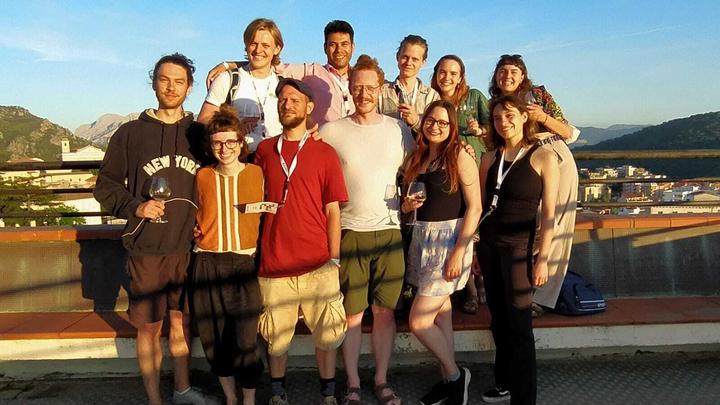Participation in the European Agroforestry Conference 2022 in Nuoro, Sardinia

As a group of 11 students and 2 teachers, we made our way to EURAF 2022 (European Agroforestry Conference), which took place in Nuoro, Sardinia this year. We first met each other through the university initiative “Krit_land”, which deals with the observation and discussion of problems in modern agriculture and, more importantly, their solutions. We used the long journey by train and ferry to exchange ideas about these very problems and to plan the conference days in such a way, that everyone could make the most of the opportunity to expand their knowledge about agroforestry. This was necessary due to the lecture program including about 30 presentations per day.
Although rivaled by numerous other highly interesting presentations, two special ones were on the must-watch list for us students, because they were being held by our accompanying teachers, Cory Whitney and Eike Luedeling. Luedeling and Whitney spoke about holistic analysis methods to support decision-making. They gave talks about agroforestry for sustainable land use in Germany and about the integration of chickens into orchards as an alternative to conventional methods of weed regulation. The whole program of EURAF 2022, as well as the abstracts of the presentations are available through the following link: https://uninuoro.it/wp-content/uploads/2022/05/EURAF2022-BOOK-OF-ABSTRACTS-Def-def.pdf. The abstracts to the presentations of Eike Luedeling and Cory Whitney can be found on pages 187 and 385 respectively.
Anna-Lea Ortmann, a student of landscape ecology at the University of Bonn, also contributed to the conference with a poster presentation. She shared parts of the results of her master’s thesis evaluating the diversity of weeds in silvo-arable agroforestry systems, their role in nature conservation and potential negative effects on crop yield. One can listen to Annas poster presentation via the following link: https://youtu.be/_TFIpy7m4qY
On the third day of the conference week, we split up into small groups and went to four different study visits, which dealt with the strongly contrasting regional approaches of integrating woody plants into agricultural systems. We saw traditional systems in which sheep and/or cattle graze under cork oaks (Quercus suber), thus enabling the simultaneous production of animal products and cork, whereby the grazing of the undergrowth also reduces the risk of forest fires. We also learned about the role of the eucalyptus windbreaks in the western part of the island, which in this situation are indispensable for crop production; their wind-breaking effect alone allows for an intensive farming system that produces most of Sardinia’s beef and over 90% of its dairy products. In addition, the seemingly inevitable ecological problems of nitrate pollution of groundwater and eutrophication of surface waters associated with these intensive farming methods were addressed and possible solutions discussed.
All in all, the visit to EURAF 2022 allowed us to gain a deep insight into the worldwide diversity of agroforestry systems and the seemingly infinite ways of integrating shrubs and trees into agriculture, thereby increasing biodiversity, climate stability and productivity. At the same time, we became aware of how important comprehensive planning of such systems is. For it is not uncommon for agroforestry to turn out labor-intensive thus being commonly perceived as unprofitable. Taking this into account, it seems all the more important to further conduct agroecological research throughout the world. Only this, in cooperation with the pioneering farmers, who already have years of practical experience in working with agroforestry, creates the necessary knowledge to enable a truly ecological and also profitable production of food.
Sardinia itself proved to be a very interesting destination in terms of, among other things, cultural history. The ancient buildings of the Nuraghi still show how closely human culture is linked to the landscape-shaping use of their natural surroundings. The Nuraghi used cork more than a thousand years BCE, for example as insulation for their still impressive stone buildings, that can be seen in many places of Sardinia.
We, the participating students of the University of Bonn, would like to thank the Foundation “Zukunft jetzt!”, the UGB as well as the INRES and especially Prof. Thomas Döring from the Department of Agroecology and Organic Farming for the generous and uncomplicated support. We are happy that this way we were able to be participants of the current scientific discourse in the field of agroforestry. With new motivation and inspiration, we are now starting our return journey and are already looking forward to the next chance to broaden our academic horizons and to get into direct contact with scientists and practitioners from Europe and the world.
Further reading
Schiffers, K., Zoe Heuschkel, Lars Caspersen, Linda Lurz, Whitney Cory W., and E Luedeling. “Decision Support for Farmers – a Systems Approach Illustrated by an Analysis on the Impact of Integrating Chickens into German Apple Orchards,” 2022. https://uninuoro.it/wp-content/uploads/2022/05/EURAF2022-BOOK-OF-ABSTRACTS-Def-def.pdf. Whitney, Cory W., Frederik Kuhl, Katja Schiffers, and Eike Luedeling. “Assessing Agroforestry Options for Sustainable Land Use in Germany.” In EURAF. Nuoro, Italy, 2022. https://uninuoro.it/wp-content/uploads/2022/05/EURAF2022-BOOK-OF-ABSTRACTS-Def-def.pdf.